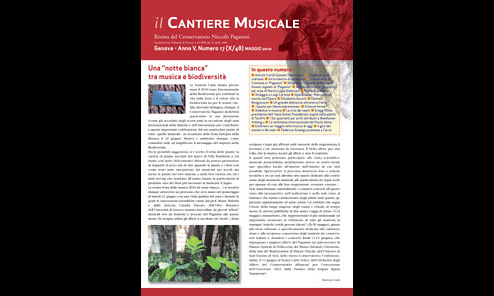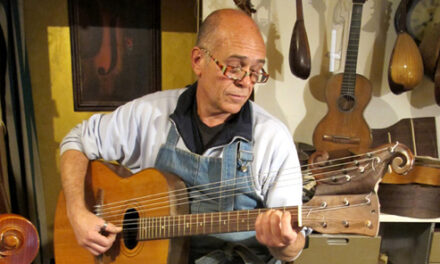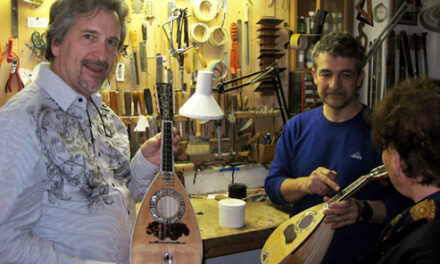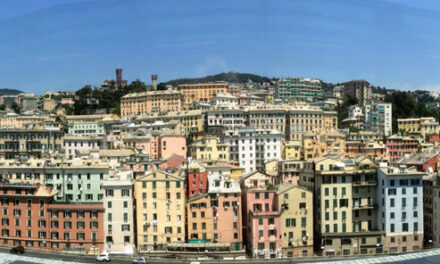I just put together a handout for the Gathering packets that includes a translation of the Genoa newspaper article on the activities there in April. Sort of a “preview” and background on what I’ll be talking about (and why) for my segments.
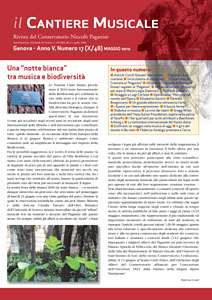
For those who would like to read a more extensive write-up that ties into the 2 talks I’ll be giving, or for those who can’t attend, here is a second, lengthy article that was published the following month in the monthly journal of Genoa’s Paganini Conservatory. This was written by my new friend there, Ljuba, a virtuoso concert pianist, who, it turned out, was apparently “interviewing” me during our frequent time together! Here is a PDF of the article in Italian, and following is my edit of the translation she kindly provided personally for me. Much ado about the pope (no, not theirs), but also a nice historical first for the city, with all that went on – apparently spurred on by my visit, and thanks entirely to the amazing Franco Ghisalberti!
GREGG MINER, PRESIDENT OF THE HARP GUITAR FOUNDATION, WELCOMED GUEST IN PASQUALE TARAFFO’S HOMELAND
Wednesday, April 28 at the Best Western City Hotel in Genoa, there was held an extraordinary meeting promoted by the passionate collector and music lover Franco Ghisalberti who, thanks to a detailed and constant pursuit, managed to find two dozen harp guitars made from the 1900’s to present day, giving rise to an exhibition of these now rare instruments, never seen in Genoa before.
His commitment was rewarded by a lively participation of aficionados and specialists in the field. Among them the President of the Harp Guitar Foundation, Gregg Miner, who came especially from Los Angeles, despite the challenge of the Icelandic volcano that raged during his trip.
On this occasion the account of an era in which the harp guitar was part of the musical Genoese traditions, now almost forgotten, and the extraordinary revival of interest and research that this instrument is experiencing overseas were combined, revealing a mosaic that little by little is restored in the awareness of cultural roots worthy of rediscovery and appreciation.
Among the harp guitars on show for the occasion were: 10 guitars of luthier Settimio Gazzo, built during the period of 1911-1919, 3 by the luthier Priano made in the 1920’s’, 1 guitar by Oreste Candi, 1 by Drasseg Victorin, 1 by Giorgio Bianchi 1932, 1 by Francesco Poggi 1924, 1 by Luigi Auciello, 1 by Adolfo Giacinti , and 2 by the Genoese “contemporary luthier” Antonello Saccu. Of particular relevance was the presence of a Harp Guitar by Gazzo made in 1916 with removable original pedestal belonging to the Taraffo family and played by his brother Rinaldo, now owned by the family Cagetti, who has kindly made it available.
Almost all the guitars on show return a piece of history of Genoese families and a perspective of the music at the popular level. It has even occurred that some of them were built personally by their owners, as was the case for the guitar “self-produced” by Giorgio Bianchi, son of Benedetto, founder and former chairman of Banco San Giorgio. Two instruments made by contemporary Genoese luthier Antonello Saccu deserve special attention: a guitar with 20 strings, built for an amateur guitarist who divides his life between his postman work and the devotion for this instrument, and a harp guitar designed and recreated for the famous Genoese guitarist Beppe Gambetta, as a modern copy of Taraffo’s Gazzo instrument, with its removable pedestal.
Gambetta, who kindly gave us his presence, in addition to providing three guitars from his collection, nicely introduced his friend Gregg Miner, President of the Harp Guitar Foundation of Los Angeles, who, during his stay in Genoa, visited luthiers and private collections, and, thanks to the kindness of the Director Patrizia Conti, also felt the great emotion to hold in his hands Pasquale Taraffo’s harp guitar kept in the Paganini Conservatory.
During the meeting, Miner, an expert musicologist as well as collector, captured the audience with a fascinating lecture on the history of the harp guitar and the international importance of the figure of Pasquale Taraffo for the evolution of this instrument.
Miner, after careful research that absorbed him for many years, wrote a long dissertation and etymological history that marked the beginning of the vast web site www.harpguitars.net dedicated entirely to the harp guitar. Today we can define with this name an instrument having at least one unfretted string lying off the main fretboard that can accommodate individual plucking. The modern harp guitar must have at least one unfretted string lying off the main fretboard; these unfretted strings are played as open strings. The word “harp” is a specific reference to the unstopped open strings, and is not specifically a reference to the tone, pitch range, volume, silhouette similarity, construction, floor-standing ability, nor any other alleged “harp-like” properties.
The harp guitar has a long and fascinating history: from mid-1600, though called by different names in the course of world history, it has resurfaced at least once every century in different places and for different purposes of music, some obsolete, others not.
The name “Harp-Guitar” was first officially adopted in 1891, when H. Hansen patented a guitar in Chicago with 6 strings plus 4 sub-basses. For the first time the patent mentions that the sub-bass strings are to be plucked: this is important because even today some people think that these were added only to produce low sympathetic vibrations. In 1895 the Norwegian Chris Knutsen invented in America a “double-neck” guitar where frets and standard strings are on the main neck, and sub-basses are on the second neck which is hollow.
It is amazing to see the similarity between this instrument and those built by Settimio Gazzo, which were first documented in the early 1900’s. From 1890 into the 1920’s the harp guitar had a great vogue in both the United States and (parts of – GM) Europe and it is still hard to determine who actually invented this instrument or “who copied who” (or even if – GM). The most interesting aspect is, however, given by the wide and simultaneous diffusion of these instruments both in Europe and overseas.
For what concerns us more closely, it is almost certain that Settimio Gazzo built by the early 1900’s Taraffo’s harps guitars: the one given to the city of Genoa from the daughter of the great guitarist was created in 1909, when the collaboration between Taraffo and Gazzo had already begun (There was at least one 14-string instrument built before the famous 1909 instrument. – GM). When and how the two did became inspired to invent a 14-string guitar?
Perhaps Taraffo’s great talent and the chromatic bass lines that he “heard in his head” would require no less than eight chromatically descending sub-basses that he tuned to lower notes. He probably himself devised the removable pedestal to support this type of guitar, a fine and unique object that, besides being aesthetically beautiful, let the sound fall and spread better.
To play such a complex instrument Taraffo had to invent and develop a unique and refined technique. Studies done by listening and watching the video in slow motion, confirm the use of an instrumental technique never used elsewhere in the world, as particular tremolos and rotational movements of the arm to touch the sub-basses very quickly without even looking at his right hand. Miner reported that when they heard for the first time in the United States CD’s by Taraffo, re-mastered by Ghisalberti, listeners thought there were two or more guitarists, believing it impossible that one performer could make such a rich and dynamic sound so vast and intense. Nor had they heard such a virtuoso harp guitar that was one of the largest of its kind in the world: in fact, other guitarists such as Mozzani and Maccaferri played a maximum of 3 or 4 low added basses, compared to the 8 that Taraffo used. Miner made some technique examples on Beppe Gambetta‘s guitar and noted that Taraffo has left no written scores of his music, and that unfortunately there is no classical guitarist who can play this instrument with such skill today.
We quote his words: “…Today we opened a beautiful new chapter on the harp guitar…it would be nice to faithfully transcribe his compositions and specific arrangements from his records directly from listening to them, to recreate and revive his music.” In this regard, Miner has shown a real enthusiasm for the idea of working with me and Ghisalberti in a joint project of the rediscovery of Taraffo’s music, his stature as a performer, composer and faithful transcriber of operas – aimed at recreating the score of the Symphony “Norma” by Vincenzo Bellini directly by listening to Taraffo’s recording and analyzing his technical and performance features.
THE SITE WWW.HARPGUITARS.NET, KEY REFERENCE POINT FOR DEVOTEES OF THE HARP GUITAR
Gregg Miner was fascinated by the harp guitar as a teenager: the incredible passion and commitment he has devoted to the study, research, collection and appreciation of this instrument has made him the recognized leading expert in this field.
In 2004 he conceived and created a huge web site dedicated to the harp guitar: a unique and valuable evolving archive, and the central hub on the World Wide Web for this instrument. It includes interesting and detailed pages on history, interpreters, iconography, discography, antique and contemporary videos, and a forum dedicated to the community of enthusiasts around the world. Impressive pages are devoted to historical and modern tunings (including those of Taraffo’s Gazzo guitar) where you can also examine those of the Renaissance lute. There is a section devoted to the particular notations used for the harp guitar, with the chance to see ancient scores, such as studies for 6 or 12 strings of Joseph Farbach of Vienna in the mid-nineteenth century, as well as the modern tablatures.
Miner maintains and updates this web site with continuous and ongoing research work, and is happy to collaborate, gather documentation and provenance from enthusiasts and specialists who want to enrich and disseminate the history of the harp guitar. Thanks to the site, he began a close cooperation and friendship with Franco Ghisalberti, which has contributed significantly to the creation of the section dedicated to Pasquale Taraffo, catalyst for international attention on the figure of the great guitarist from Genoa. Here you can find very accurate biographical and historical notes, his whole discography (which lists all the labels’ 78’s), photographs, posters and international reviews of his concerts and a rare video as well. Worth mentioning are also the chapters on the instruments made by Genoese luthiers Gazzo, Candi, etc.., Genoese guitarists and the cultural background of this era. The exploration of this site is fascinating and compelling: a musical adventure through the Internet that will never end.
THE HARP GUITAR FOUNDATION AND ITS “GATHERING”
In 2009, after five years of growth of the web site, The Harp Guitar Foundation was created, whose president is Gregg Miner, made possible largely by the support of 200 subscribers and benefactors who contributed to the site and its growth. It is a Non Profit Public Benefit Corporation created to preserve, support, and enrich the world of the harp guitar, expanding the historical documentation, and to serve the worldwide community of fans of this instrument, its performers, researchers, collectors, luthiers and restorers, and project the harp guitar into the future through the experience of new music, new interpretations and new discoveries.
The important annual event is the “Harp Guitar Gathering,” a festival that brings together lovers of the harp guitar which began in 2003 in Virginia, thanks to the idea of the famous guitarist Stephen Bennett; on this occasion he gathered such a great number of harp guitar (fans) as has never been seen before. Following the success of this first meeting, the event has become annual, and was organized in Oregon, Florida, etc., receiving enthusiastic participants from all over the world (England, Canada, Belgium, Japan, etc.). All these people, motivated by the desire and joy of meeting and “making music” together, give life to a full immersion of meetings, conferences, and seminars. The 8th Harp Guitar Gathering will be held at the Athenaeum Theatre in Indianapolis next November, 2010.
GREGG MINER – “…IN SEARCH OF THE LOST SOUND” – THE MUSEUM AND RECORDINGS
Gregg Miner is a collector, performer, and musicologist, but also an archivist of rare and unavailable instruments. His musical education includes a wide variety of genres: he studied classical guitar, rock, jazz, lute, mandolin, and classical harp (studying with the famous Mildred Dilling). His desire to play every instrument which he found led him to set up a collection of hundreds: some historical instruments that could not be found were commissioned from the most skilled luthiers to be faithfully reconstructed. Many instruments in his collection are unique.
His museum – “The Miner Museum of Vintage, Exotic and Just Plain Unusual Musical Instruments” – can be visited “virtually” on his site www.minermusic.com and is an amazing mine that includes hundreds of specimens of string instruments, cataloged by family, year and maker, harp guitars (including one of Settimio Gazzo, and one by Mozzani, beyond those by Knutsen, Dyer and Gibson), mandolins (including a Monzino harp-mandolin), citharas, harps, lutes, Dolceola and orpharion, Meloharp, ethnic instruments and exotic banjos, ukuleles and balalaikas, plus many unusual hybrids like the Pianophone and Miner-Cello of his own invention, and others, ad infinitum.
Animated by the desire not only to own these wonderful instruments, but bringing their sound to a new life, Miner has personally had them restored and recreated the techniques, performance practices and every nuance of each style, making them the protagonists of his recordings. Of extreme interest is the 2-CD collection, “A Christmas Collection,” in which you can now listen to the voices of lost and forgotten lyres, harps, Octophone, mandocello, chitarrone, Viola da Gamba, tromba marina, and of course, harp guitars: one hundred rare instruments that, under the sensitive fingers of Miner, come back to life in a very fascinating musical path. His versatile interpretation is amazing as is the refinement of his arrangements of folk and traditional Christmas songs: namely the Choir “Joy of Man’s Desiring” for Mandolin, Mandocello, Mandola and Mando-Bass which strikes one with its vibrant vitality, “The Ukrainian Bell Carol” for soprano and bass balalaika and bandura, the 17th century Provencal song “Bring a Torch, Jeanette, Isabella,” played on a Dyer Harp guitar of the 1910’s (absolutely one of the favorite instruments) – all evoke very ancient suggestions. The booklets accompanying the CD are treated in detail with beautiful photographs, historical notes and tuning of each instrument, and can be considered a real mini encyclopedia of sounds and images precious for every music lover.
By Ljuba Moiz
(all rights of mistakes reserved)
from “ Il Cantiere Musicale”, the “Nicolò Paganini” Conservatory Magazine, Anno V,n°17,Maggio 2010

